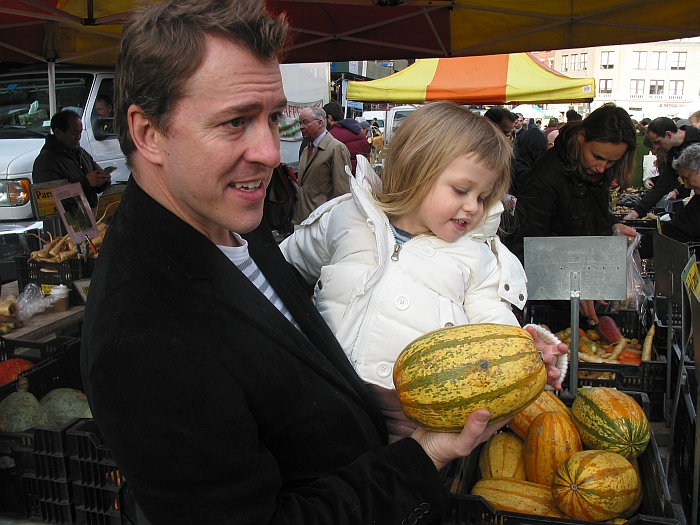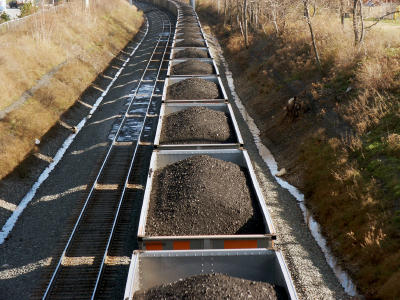In November 2006, Michelle Conlin began a year-long experiment in extreme sustainability, resolving to burn no fossil fuels, produce no trash, and eat only food grown within 250 miles of her Greenwich Village home. She gave up nearly all shopping and learned to use cloth diapers for her 2-year-old daughter. She took up bicycling and rode a scooter to work. Describing her earlier self as “espresso-guzzling, retail-worshipping” and a “take-out junkie,” she gave up coffee (with some lapses) and to-go food. Eventually she gave up electricity at home, relying on candles in her 9th-floor apartment and lots of stair climbing.
 Michelle, Isabella, and Colin, still smiling.Photo courtesy Oscilloscope Laboratories
Michelle, Isabella, and Colin, still smiling.Photo courtesy Oscilloscope Laboratories
Conlin, a 42-year-old reporter at Business Week, had no blog, book deal, or film project to send her on this journey of sacrifice and self-denial. What she had was a husband.
By fortune or misfortune, Conlin is married to Colin Beavan, the self-described No Impact Man. He cooked up the No Impact Man stunt as fodder for a book of the same name, out Sept. 1. He keeps a No Impact Man blog. And a film crew recorded his year for No Impact Man the movie, also released next month.
Beavan, 45, says he undertook the project to learn if his own lifestyle could become part of a solution to the world’s environmental crises. In writing about his motivation, he says he was afraid of becoming “that brand of liberal who whines about the world but doesn’t actually do anything about it.”
“If I were still a student, I’d probably march against my adult self,” he quips.
Hence, the bathtub full of laundry and the winter dinners of local cabbage. Also, because of the deforestation crisis, no toilet paper.
While Beavan gets all the attention and the superhero nickname, his wife and their 2-year-old daughter, Isabella, are dragged along for the un-motorized ride. That’s a good thing for the film, because Conlin emerges as the most vivid character for the simple reason that she struggles to make such drastic changes in her life.
Beavan, despite his claims that he was a do-nothing liberal, seems like he was just waiting for a reason to build a kitchen compost bin, mix up natural cleaning supplies, start buying groceries at the Union Square farmers market, etc, etc. The movie shows him reflecting on and defending the project, it shows him visibly losing weight over the year, but you don’t really see him struggle.
Conlin is more sympathetic because she misses coffee and tires of eating local root vegetables. She thinks, understandably, that a year is a long time to go without buying new clothes. While No Impact Husband devotes much of his day to cooking, cleaning, and making the experiment work, she keeps her day job. The filmmakers play up Conlin’s “espresso-guzzling, retail-worshipping” characterization, but it’s still clear this is difficult for her.
The movie opens with Beavan backstage at The Colbert Report, practicing different ways of explaining his shtick. This is telling, as a lot of the movie is about the couple explaining the project. A New York Times profile about them serves as a plot development, because they’re shocked at how strongly and negatively readers react to their project.
“I didn’t quite get why people hated us,” says Conlin. She visits Eating Liberally blogger Kerry Trueman, who wrote a scathing post about No Impact Man before softening her view of the enterprise.
“This really touches a nerve for people,” Trueman says. “Aside from making people feel guilty and defensive about their consumer habits, people are very traumatized if you suggest that they should make do without something.”
Others weren’t angry but dismissive, leading Beavan to complain about the Times profile headline, “The Year Without Toilet Paper.”
 Beavan holds Isabella at the Union Square Greenmarket. Photo courtesy Oscilloscope Laboratories
Beavan holds Isabella at the Union Square Greenmarket. Photo courtesy Oscilloscope Laboratories
“What if we called it the year I lost 20 pounds without going to the gym once?” he says. “Or the year we didn’t watch TV and became much better parents as a result? Or if we called it the year we ate locally and seasonally and it ended up reversing my wife’s pre-diabetic condition?”
But if the project is meant to get people talking—and Beavan says it is—it succeeded. Colbert, Good Morning America, and a slew of other media called to get his story. Sony/Columbia bought the right to rework the story as a drama that could, reportedly, include Will Smith. (Weird, I know.)
At some point toward the end of his project Beavan makes the discovery that he isn’t alone in working toward sustainability. He visits a project to reintroduce oysters in the Hudson River and an industrial cleanup project in the Bronx and says, “There is this network of people who have been working on this stuff forever.”
It shouldn’t have taken a year-long experiment to figure that out, but Beavan understands that the publicity gods reward stunts like No Impact Year. To my knowledge, the Bronx cleanup people haven’t been invited on Good Morning America.
Beavan undertook the project expecting that it would launch a more politically engaged stage in his career. (He has a Ph.D. in electronic engineering and wrote previous books about the history of forensics and D-Day.) After learning that 12,000 diesel trucks a day pass through the Bronx neighborhood he visited, he reports, “The diesel particulates in the air are causing asthma in kids, causing brain damage in kids … I’m not talking about the polar bears, I’m not talking about people in faraway island communities who are going to be hurt when the ocean levels rise. I’m talking about people who are already feeling the effects of our over-consumptive society.”
I hope his work keeps moving in this direction. In explaining why he flipped off his apartment’s circuit breakers earlier in the film, he says, “I can’t change the way that electricity is delivered to my house.” I wanted to tell him that a lot of engineers, activists, and citizens are working hard because of their conviction that—together–they can change where electricity comes from.
He seems to sense this when he installs a rooftop solar panel and says, “For the first time I’ve realized that it’s not about using as little as I can possibly use, but finding a way to get what I need in a sustainable way.”
It might be an artificial revelation at the end of a patently artificial “experiment.” Then again, even Thoreau’s shack at Walden Pond was a stunt, with a book deal always in mind. Walden proved both deeply irritating and useful to those who were unsettled by it. No Impact Man (the movie) inhabits that tradition well.
One more note: It’s a thoroughly fun movie to watch, with great music. Watching Beavan reading Gawker comments about himself gives a sense of how hard it can be to dramatize a story about not doing things. But filmmakers Laura Gabbert and Justin Schein make the most of the Manhattan setting, using traffic jams, overflowing trash cans, and belching exhaust pipes as foils to Beavan and Conlin’s clean living. They got into the no-impact spirit, shooting from a bicycle rickshaw while filming the couple on their bikes.
Find out when the movie is coming to your city, and watch the trailer:


